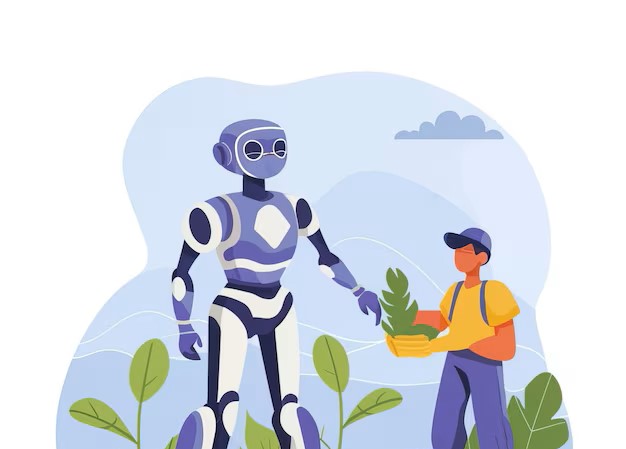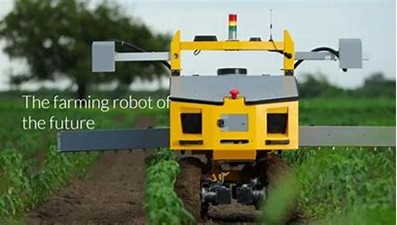Transforming Indian Agriculture: The Role of AI Technology
 Harini S
Harini S
Indian agriculture plays a crucial role in feeding 1.3 billion people. Despite economic challenges during COVID-19, it remained resilient, contributing 18.8% to GVA in 2021-22 and reducing dependence on imports. However, the sector faces hurdles, including fragmented landholdings, climate change, soil degradation, market inefficiencies, and water scarcity.
Agrarian reforms, Government initiatives, agricultural modernization including the Green Revolution, water management, and crop diversification, are addressing these issues, but AI has the potential to bring even more change.
How AI help in Agricultural Reforms:
Precision Farming with AI:

Imagine if you’re a farmer, and you have a farm where each crop gets exactly what it needs. That’s precision farming! By integrating data from sensors, satellite imagery, drones, and ML algorithms, precision farming empowers farmers to make informed, data-backed decisions that improve efficiency and sustainability.
Cropin, gives precise farming solutions through its cropin Apps, Cropin’s Data Hub, and AI models that offers real-time weather updates, soil health data, and crop growth monitoring. This optimizes irrigation and usage of fertilizers.
Crop Health Monitoring and Pest Management:

Pests, like bugs or fungi, makes hard for farmers by damaging crops. Here the solution is an AI-powered drone, who can fly over fields, spotting early signs of pests or diseases on plants and thereby reporting the farmer. Saving crops and reducing chemical use!
Plantix is an ag-tech app that helps farmers identify and treat crop diseases, which helps to improve productivity and learn farming knowledge.
Automation and Labor Efficiency:

Robotic machinery, such as autonomous tractors and harvesters, improves farm operations by carrying out tasks like planting, weeding, irrigation, and harvesting. This enhances resource utilization while also greatly lessen human effort giving farmers more time, particularly in areas with labour shortages.
For example, TartanSense is an Indian startup that has developed an AI-powered robot called the TartanSense Weeding Robot. It helps farmers by autonomously detecting and removing weeds from fields, reducing the need for manual labor and herbicide use.
Increase Farmer Income:

AI helps farmers by studying market trends and predicting prices. It can tell them what to grow and when to sell for the best price. It enhances the efficiency of India's intricate agricultural supply chain by offering real-time data, improving logistics, and forecasting demand, thereby minimizing delays and losses.
AgriBolo with the motto of 'For the farmer, By the farmer and with the farmer', provides a 360-degree solution to the farmers through competitive input prices, highest prices for farm output and increase income further by creating rural entrepreneurs.
other contributions of AI in agriculture include …
AI-powered predictive models can deliver highly accurate weather forecasts, conserving water and enhancing crop health by preventing over- or under-irrigation.
IoT sensors to track environmental factors such as soil moisture and temperature.
AI-powered inventory management helps maintain ideal storage conditions and predict demand.
AI-powered precision irrigation systems conserve water by analyzing soil and weather data to use drip irrigation.
AI supports climate-smart agriculture by increasing resilience to extreme weather, and lowering carbon emissions.
AI tools help farmers cut their carbon footprint by optimizing resources, encouraging no-till farming, and improving sustainable livestock management to reduce greenhouse gas emissions.
The use of sensors and drones track soil and crop conditions, which improves soil fertility and crop development.
Barriers to AI adoption in Indian Agriculture:
High Costs of AI tools and Low Digital Literacy and Language Barriers.
Rural infrastructure, including limited internet connectivity and electricity.
High data costs for using AI tools that rely on real-time data.
Frequent power outages and inconsistent electricity supply disrupt the use of AI-powered devices.
Way Forward and Conclusion:
The integration of AI in Indian agriculture has the potential to revolutionize the industry by making farming smarter, more efficient, and resilient. AI can improve crop yields, optimize resource use, automation of labour-intensive tasks, increase agricultural productivity, lower costs, and improve farmers' livelihoods. Though there are some barriers in adopting AI, efforts to provide local-language platforms and training are ongoing. As India embraces these technological advances, AI will continue to drive sustainable growth and food security for the future.

Subscribe to my newsletter
Read articles from Harini S directly inside your inbox. Subscribe to the newsletter, and don't miss out.
Written by

Harini S
Harini S
As an aspiring Machine Learning Engineer, I am currently interning at Invisibl Cloud, focusing on MLOps. My hands-on experience includes projects in Langchain, prompt engineering, and Software Engineering. I am passionate about leveraging my skills to drive innovation in machine learning and look forward to contributing to impactful projects in the future.